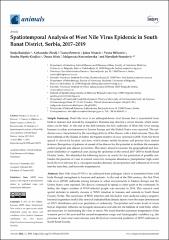| dc.contributor.author | Radojičić, Sonja | |
| dc.contributor.author | Živulj, Aleksandar | |
| dc.contributor.author | Petrović, Tamaš | |
| dc.contributor.author | Nišavić, Jakov | |
| dc.contributor.author | Milićević, Vesna | |
| dc.contributor.author | Sipetić-Grujičić, Sandra | |
| dc.contributor.author | Mišić, Dušan | |
| dc.contributor.author | Korzeniowska, Malgorzata | |
| dc.contributor.author | Stanojević, Slavoljub | |
| dc.date.accessioned | 2021-10-14T08:42:24Z | |
| dc.date.available | 2021-10-14T08:42:24Z | |
| dc.date.issued | 2021 | |
| dc.identifier.citation | Radojicic, S.; Zivulj, A.; Petrovic, T.; Nisavic, J.; Milicevic, V.; Sipetic-Grujicic, S.; Misic, D.; Korzeniowska, M.; Stanojevic, S. Spatiotemporal analysis of West Nile virus epidemic in South Banat District, -Serbia, 2017–2019. Animals 2021, 11, 2951. https://doi.org/10.3390/ani11102951 | en_US |
| dc.identifier.issn | 2076-2615 | |
| dc.identifier.uri | https://repo.niv.ns.ac.rs/xmlui/handle/123456789/422 | |
| dc.description.abstract | West Nile virus (WNV) is an arthropod-born pathogen, which is transmitted from wild
birds through mosquitoes to humans and animals. At the end of the 20th century, the first West
Nile fever (WNF) outbreaks among humans in urban environments in Eastern Europe and the
United States were reported. The disease continued to spread to other parts of the continents. In
Serbia, the largest number of WNV-infected people was recorded in 2018. This research used
spatial statistics to identify clusters of WNV infection in humans and animals in South Banat
County, Serbia. The occurrence of WNV infection and risk factors were analyzed using a negative
binomial regression model. Our research indicated that climatic factors were the main determinant
of WNV distribution and were predictors of endemicity. Precipitation and water levels of rivers
had an important influence on mosquito abundance and affected the habitats of wild birds, which
are important for maintaining the virus in nature. We found that the maximum temperature of the
warmest part of the year and the annual temperature range; and hydrographic variables, e.g., the
presence of rivers and water streams were the best environmental predictors of WNF outbreaks in
South Banat County. | en_US |
| dc.description.sponsorship | The publication is co-financed under the Leading Research Groups support project from
the subsidy increased for the period 2020–2025 in the amount of 2% of the subsidy referred to Art.
387 (3) of the Law of 20 July 2018 on Higher Education and Science, obtained in 2019. The study
was supported by the Ministry of Education, Science and Technological Development of the Republic of Serbia, grant numbers 451-03-9/2021-14/200143 and 451-03-9/2021-14/200031. | en_US |
| dc.language.iso | en | en_US |
| dc.source | Animals | en |
| dc.subject | West Nile virus | en_US |
| dc.subject | mosquitoes | en_US |
| dc.subject | sentinel animals | en_US |
| dc.subject | spatial analysis | en_US |
| dc.subject | GIS | en_US |
| dc.title | Spatiotemporal Analysis of West Nile Virus Epidemic in South Banat District, Serbia, 2017–2019 | en_US |
| dc.type | Article | en_US |
| dc.identifier.doi | 10.3390/ani11102951 | |

